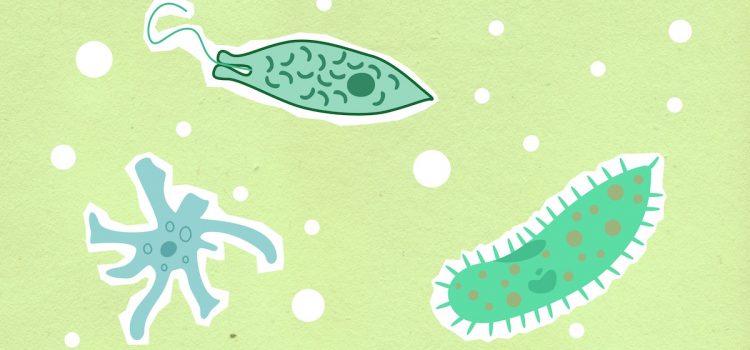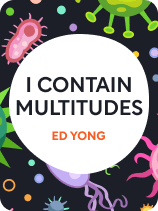

This article is an excerpt from the Shortform book guide to "I Contain Multitudes" by Ed Yong. Shortform has the world's best summaries and analyses of books you should be reading.
Like this article? Sign up for a free trial here.
What is I Contain Multitudes by Ed Yong about? Aside from common microorganisms, how do the trillions of other microbes affect us and the environment?
I Contain Multitudes by Ed Yong is about the mysterious and fascinating world of microbes. In the book, Yong claims that although we often think of ourselves as individuals, we’re essentially walking ecosystems containing countless species of microbes living in symbiotic partnership with us.
Read on for a brief overview of I Contain Multitudes: The Microbes Within Us by Ed Yong.
I Contain Multitudes by Ed Yong
When most people think of microbes, the first things that come to mind are disease-causing germs or healthy probiotic yogurts. We go about our lives largely unaware of the trillions of microbes on every surface and throughout our bodies, influencing everything from coral reefs to the physical and mental health of humans. I Contain Multitudes by Ed Yong explores the mysterious and fascinating world of microbes: microscopic organisms with the ability to make sea creatures glow, eradicate diseases, and nudge ecosystems into disarray.
Yong argues that not only are microbes ubiquitous, but they’re also integral to animal bodies (including humans). And by understanding the ways that we’re interdependent with microbes, we can then explore opportunities to use microbes to improve our health.
Yong is a British-American science journalist reporting for The Atlantic. He won a Pulitzer Prize for his coverage of the Covid-19 pandemic and authored two New York Times best sellers, I Contain Multitudes and An Immense World. In I Contain Multitudes, he uses his ability to explain complex science through storytelling to give readers a new perspective on life and our connections to other organisms. He explains that although we often think of ourselves as individuals, we’re essentially walking ecosystems containing countless species of microbes living in symbiotic partnership with us. Fittingly, the book title quotes the Walt Whitman poem “Song of Myself,” which conveys a sense of oneness with the living world.
What Is a Microbe?
“Microbe” is a catch-all term for microorganisms, living things that are too small to see with the naked eye. Yong explains that microbes exist in many forms, broadly categorized as bacteria, fungi, and viruses. (Shortform note: Protozoa is another scientific category of microbes that Yong doesn’t discuss in detail. Protozoa are single-celled organisms that are sometimes parasitic and cause diseases such as malaria.)
Within these categories, other terms are often used to indicate a microbe’s function. For example, pathogens are disease-causing microbes, probiotics are microbes that produce a health benefit, and bacteriophages (also known as phages) are viruses that eat bacteria.
Although pathogens are generally considered “bad” microbes, Yong asserts that microbes aren’t inherently bad or good. In his analogy of individual people as ecosystems of interacting microbes, Yong compares pathogens to invasive species—plants or animals that have a negative impact when they’re introduced into a new environment without any natural predators to control their population. Likewise, instead of painting microbes in broad strokes, he argues that it’s important to consider the context in which microbes cause harm to humans.
History and Functions of Microbes
For billions of years, microbes were the only living organisms on the planet. I Contain Multitudes by Ed Yong puts this in perspective, condensing the earth’s history into one calendar year. On this time scale, microbes entered the scene in March, plants and sea creatures appeared in November, and humans have only been around for the last 30 minutes at most.
(Shortform note: David Attenborough first introduced this concept of the “cosmic calendar” in his television series Life on Earth to help people conceptualize the evolutionary history of the universe. Since then, it’s become a common tool for expressing the relatively small period of time that humans have been around. Although Ed Yong’s I Contain Multitudes implies that the cosmic calendar begins when Earth formed about 4.5 billion years ago, the calendar actually condenses the 14 billion years of the universe’s history into one year. On this time scale, each month is just over 1 billion years, and a human lifespan of 75 years is only 0.16 seconds.)
Yong emphasizes that not only have microbes been around much longer than any other life form on Earth, microbes actually created the conditions for other living organisms to evolve. Bacteria are responsible for breaking down organic matter and converting nutrients such as carbon and nitrogen into forms that plants and animals can use. Bacteria were also the first organisms to photosynthesize, the process by which plants harness energy from the sun and produce oxygen as a byproduct. Photosynthesis by early bacteria created the oxygenated atmosphere that enabled the animal kingdom to come into existence.
Microbes Shape Animals and Their Protection From Predators
In I Contain Multitudes, Ed Yong explains that microbes are an integral part of animal defense systems because they can alter an animal’s body and activate specific genes to make it less vulnerable to predation. (Shortform note: Microbes not only defend animals but also attract other organisms. For example, the unique scent produced by microbes in an elephant’s urine signals to other elephants its sex and mating readiness.)
In one of Yong’s examples, a single bacterium species is responsible for the unusual self-defense mechanism of the Hawaiian bobtail squid. The bobtail squid has a pair of organs on its underside that glow at night, matching the luminescence of the moon. This eliminates the squid’s shadow, helping it hide from predators. However, these bioluminescent organs rely on the bacterium V. fischeri to mature fully.
First, the squid uses mucus and small hairs called cilia to attract V. fischeri to its surface. When these bacteria enter the inner chambers of the light organs, they begin to activate the squid’s genes that make its body inhospitable for other types of bacteria and create enzymes that attract even more of the V. fischeri. Once this bacteria species successfully colonizes the squid, the light organ matures and begins to glow. The bacteria both trigger organ maturity and enable bioluminescence throughout its life.
(Shortform note: This defensive strategy is called counter-illumination, and it protects animals from predators like sharks that hunt from below. Some squids also use bioluminescence by flashing their light to startle potential predators (like fish), giving them a chance to escape. Other sea creatures like brittle stars detach a bioluminescent body part as a decoy for predators, and some sea cucumbers detach a bioluminescent body part and place it on another fish.)
Microbes Shape the Immune System in Humans
Yong also describes how microbes contribute to the early development of humans through our immune system. He specifically points to vaginal births and breastfeeding as key points when microbes establish immunity.
During a vaginal birth, babies inherit an entire microbiome (a community of microbes) from their parent as they contact millions of bacteria in the birth canal. Yong writes that a baby’s immune system is naturally suppressed during the infant’s first weeks of life so that these beneficial microbes can colonize the baby’s body and provide instructions to immune cells about what microbes they should respond to.
Yong also describes research showing that breast milk contains dozens of varieties of human milk oligosaccharides (complex sugars called HMOs) that nourish the bacteria in a baby’s gut.
(Shortform note: Although Yong doesn’t explicitly define his use of the word “gut” throughout the book, it generally refers to the entire gastrointestinal system, including the stomach, large intestine, small intestine, and rectum.)
Microbes Impact Brain Development Through the Gut-Brain Connection
According to Ed Yong’s I Contain Multitudes, beyond immunity, research illuminates links between the gut microbiome, the immune system, and brain development. Because of the vagus nerve, which directly connects the brain to the gut (where trillions of microbes live), certain brain activities depend on signals from gut microbes. Therefore, Yong posits that the absence of certain microbes is linked to abnormal brain development. This two-way communication between the brain and the gut is called the gut-brain axis.
Microbes Form Interdependent Relationships With Animals
While the last section focused on the ways that microbes help shape animals fundamentally, we’ll now explore the ways that microbes influence animal life through long-term interdependent relationships. These relationships are more like conventional symbiosis, where both partners gain a mutual benefit, and they include food symbiosis and co-management of the immune system.
Food Symbiosis: Yong explains that microbes enter into food symbiosis with animals by evolving ways to expand the animal’s food options. Animals benefit from increased food access, and the microbes ensure the survival of animal hosts that provide food, habitat, and future generations of hosts.
Microbes and Immune Cells Co-Manage Our Immune System: In addition to enabling food symbiosis, microbes form life-long interdependent relationships with humans by co-managing our immune systems with immune cells. Yong argues that the common conception that the immune system’s primary job is to eliminate “bad microbes” is incomplete. Instead, he describes it as a constant fine-tuning process of keeping microbe populations in a healthy balance.
Human Lifestyles Impact Microbial Ecosystems
Now that we’ve covered how microbes are linked to animal development, as well as how microbes form long-term interdependent relationships with animals through food and immunity, we’ll talk about how humans are altering microbial populations at an unprecedented rate.
Shifts in Microbe Populations Contribute to Ecological Collapse
Because of human activity in oceans around the world, ecosystems like coral reefs are declining rapidly due to a shift in microbial populations. In I Contain Multitudes, Ed Yong asserts that for coral reefs, this decline often starts with the presence of iron from boats and other human-made structures that cause rapid growth of fleshy algae. This fleshy algae growth is also happening in the context of humans overhunting sea animals and polluting oceans, which drastically reduces the population of fish and other sea creatures that would normally eat the fleshy algae and moderate its population.
As a result, the fleshy algae produce an overabundance of a substance called dissolved organic carbon (DOC), and the bacteria that live on coral consume the DOC, grow exponentially, and essentially suffocate the coral. In other words, the disruption of nutrients in the water causes the microbiome of the coral itself to grow uncontrollably and kill the host organism. Other stressors like pollution and the increasing temperature and acidity of oceans further disrupt the microbiome.

———End of Preview———
Like what you just read? Read the rest of the world's best book summary and analysis of Ed Yong's "I Contain Multitudes" at Shortform.
Here's what you'll find in our full I Contain Multitudes summary:
- A deep dive into the mysterious and fascinating world of microbes
- How commercial probiotics have oversold health benefits
- How modern sanitation practices are harming us






